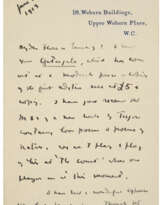ID 1108995
Lot 195 | William Butler Yeats (1865-1939)
Valeur estimée
£ 15 000 – 20 000
Series of 30 autograph letters and two letters signed ('W.B. Yeats') to Elizabeth Radcliffe, 18 Woburn Buildings, Coole Park, Stone Cottage, Paris and elsewhere, mostly undated, [postmarks 9 June 1913 - 18 October 1917]
Together approx. 74 pages in autograph and 12 in other hands, various sizes, a few letters with Yeats's sketches of crosses and other symbols; with a related letter. Most with envelopes. Provenance: Property of a Lady; Sotheby's, 15 & 16 December 1980, lots 420-451 (sold as a single lot).
‘A year ago your spirits saved me from serious error in a crisis of life. I need their advice again': letters to a young medium. The principal subject of the correspondence is Yeats's attempts to interpret and identify scripts and names produced by Elizabeth Radcliffe through 'automatic writing' in their seances: his research includes consulting a curator at the British Museum on Egyptian and Greek scripts, sending to Somerset House for the will of one individual and asking Raymond Asquith to use Winston Churchill's influence as Home Secretary to identify a mysterious policeman. Yeats constantly stresses the urgency and importance to him of the spirit communications, and his astonishment at the information conveyed: 'I can never make known to you my profound gratitude. You have changed most things for me & I know not how far that change will go’; 'The matter is of tragic importance'; 'I want you to thank the spirits for their good will … I am trying to ask nothing they may not give'; after identifying a 'Sister Mary Aloysius' named by Radcliffe as a nun in Gort convent he exclaims 'I am overwhelmed with the wonder of this discovery’ (21 July 1913); ‘I believe that your spirits wish us to try to meet every week or so … I think we should take the symbols they have drawn & try to get their meaning in meditation’ (2 December 1913); ‘A year ago your spirits saved me from serious error in a crisis of life. I need their advice again. Would you ask them?' (29 December 1913). He tries to introduce Radcliffe to Rabindranath Tagore: ‘I told him you did not like to have it known you did automatic writing … He is a great saint & a great man so perhaps you would care to. Your secret would be safe with him'; on more mundane matters, he invites her to see the Irish Players at the Royal Court (c. June 1913). A striking letter of 26 October [1913] recounts a dream, apparently in relation to Maud Gonne: 'About the evil eye. Twenty years ago certain things were going very badly with me. I said going to bed "I will find out before I wake what is wrong". I meant to find out in dreams or visions about the mind & circumstance of a girl I was in love with who was acting rather strangely as I thought'. A letter of 18 May 1916 interestingly interprets a word used in a seance as 'a reference to the Irish Rebellion' (i.e. the Easter Rising of the previous month, the subject of a famous poem). In November [?1916] Yeats writes apologetically after reports of a meeting in Dublin in which he had discussed her are published in a newspaper, explaining 'My thoughts have been filled with the problem of your script for months. It contains the most important evidence I know on the most important problem in the world’.
Elizabeth Radcliffe (from 1922 Lady Gorell, 1886-1954) was introduced to Yeats in 1913, probably by Eva Fowler (Yeats's amanuensis in a letter of November [1916] present here). She acted as his medium for the next four years, until his wife Georgie assumed the role.
| Artiste: | William Butler Yeats (1865 - 1939) |
|---|---|
| Lieu d'origine: | Irlande, Royaume-Uni |
| Artiste: | William Butler Yeats (1865 - 1939) |
|---|---|
| Lieu d'origine: | Irlande, Royaume-Uni |
| Adresse de l'enchère |
CHRISTIE'S 8 King Street, St. James's SW1Y 6QT London Royaume-Uni | |||||
|---|---|---|---|---|---|---|
| Aperçu |
| |||||
| Téléphone | +44 (0)20 7839 9060 | |||||
| Commission | see on Website | |||||
| Conditions d'utilisation | Conditions d'utilisation |




















